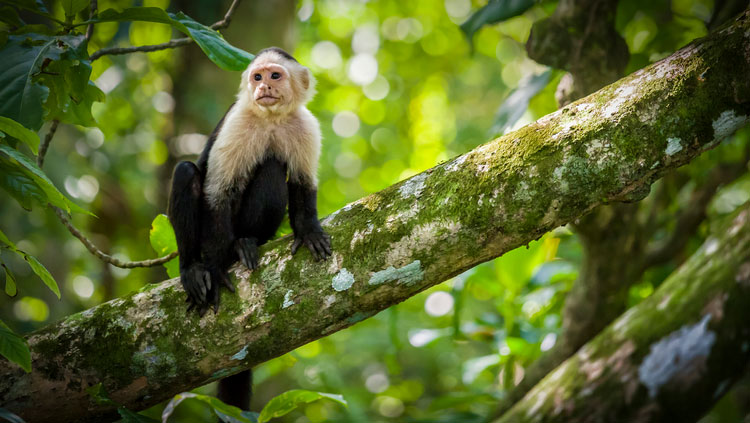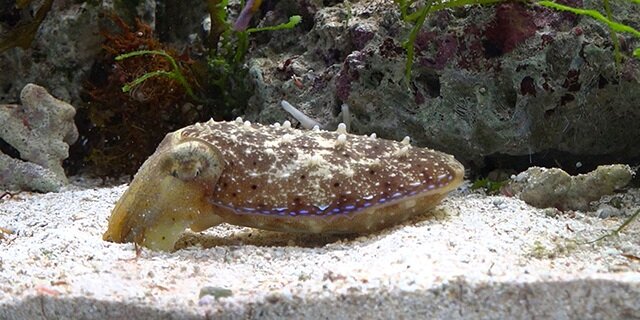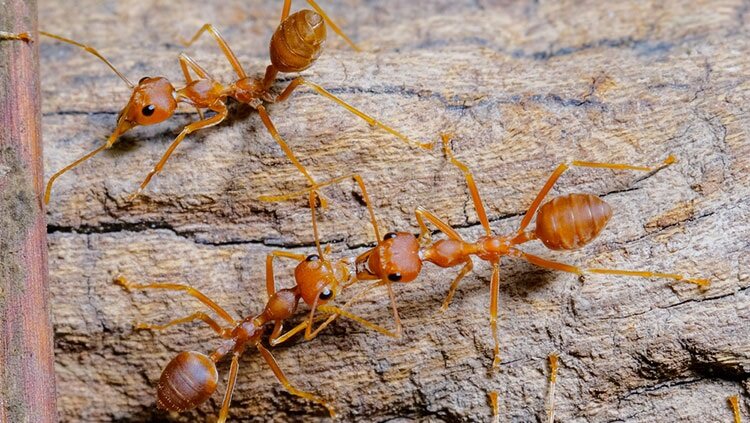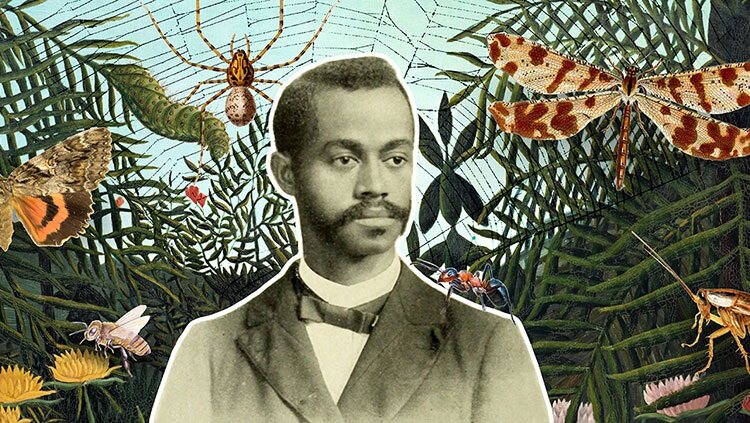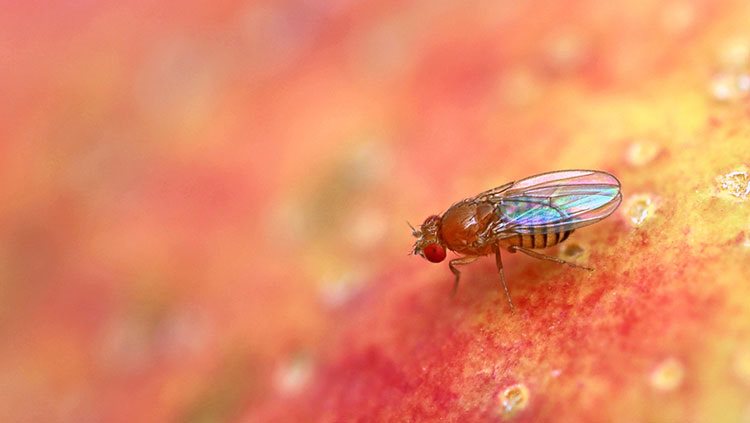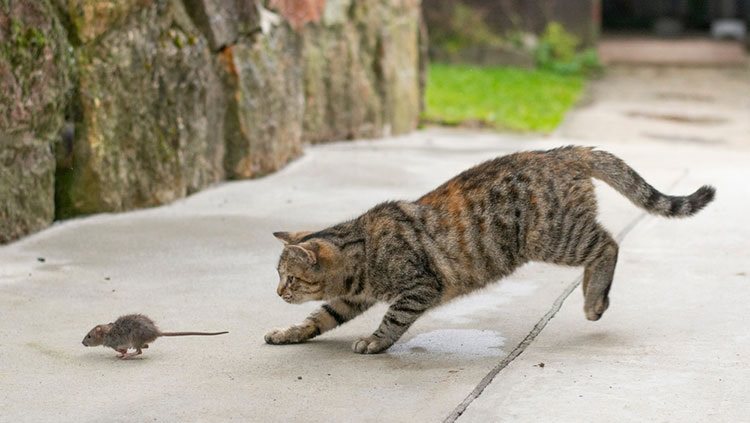Octopuses on MDMA Hint at the Evolution of Social Behavior
- Published5 Feb 2021
- Author Hannah Thomasy
- Source BrainFacts/SfN
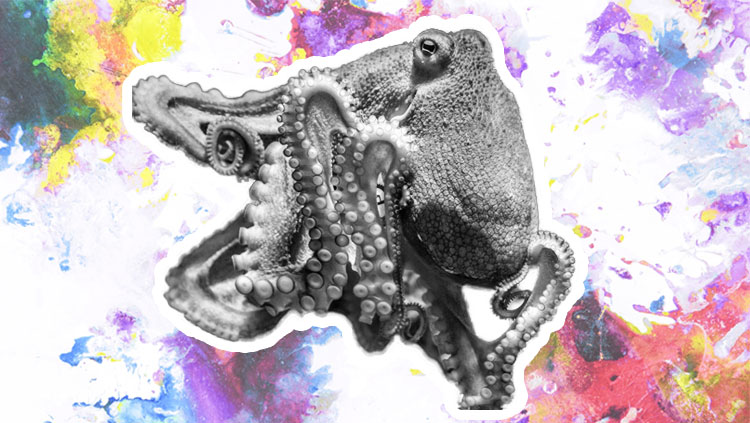
In neuroscientist Gül Dölen’s lab at Johns Hopkins University, a small octopus scoots along the bottom of its tank. Its sucker-covered tentacles creep up the glass walls. Finding another octopus in a mesh container, it drapes its long arms over the container, trying to touch its fellow cephalopod in an underwater embrace.
For the California two-spot octopus, this behavior is quite unusual. The species is generally asocial. Normally it would avoid — or even attack — another octopus.
But the octopuses in Dölen’s lab have had a little pharmaceutical help with their social skills: they’re high on MDMA.
Dölen wants to understand the brain structures and chemicals that govern social behavior — how they work in typical brains, what goes wrong in disorders with social impairments like autism and schizophrenia, and how they evolved over millennia.
Party drug MDMA activates our brain’s serotonin system and makes us more sociable. At first glance, Dölen’s octopus study seems to suggest the notoriously asocial creatures possess this same wiring — a tantalizing idea that may warrant a more cautious interpretation and further study.
A Role for Serotonin
Dölen has studied social behaviors in mammals for over a decade. But in 2015, an international team of researchers sequenced the entire genome of the California two-spot octopus. Dölen wasn’t involved in the work, but she noticed the octopus carried a gene very similar to one in humans. The gene encoded a serotonin transporter, a protein that sops up extra serotonin neurotransmitters from synapses.
“Serotonin is one of the oldest neurotransmitters we know of,” says Dölen. “In mammals at least, it’s been implicated in almost everything you can think of, from digestion, to social behaviors, to mood.”
Dölen wanted to see whether serotonin was involved in social behaviors in octopuses, the way it is in humans. This is where MDMA comes in — it acts on this serotonin transporter and, at least in mammals, strongly promotes social behavior.
In her study, Dölen and colleagues used a tank with three connected chambers. On one side, they put a plastic toy. On the other, an octopus covered with a small mesh enclosure. The test octopus was placed in the middle chamber.
Under normal conditions — without MDMA — the octopuses spent more time in the chamber with the toy. If they ventured over to the other octopus, they were standoffish. “They would stick to the walls and maybe, like, poke out one arm and then come back,” Dölen says.
But when they were on MDMA, they opted to spend more time with their fellow cephalopod. They even seem more relaxed and friendly, draping their arms all over the enclosure containing the other octopus.
“This was super exciting because it meant that even though [these] octopuses are asocial, they have all of the brain circuitry necessary to be social and that all you need to do to trigger that brain circuitry is activate the serotonin transporter in the way that MDMA does,” says Dölen.
Design Flaws
While the results are exciting, some scientists have raised concerns about the study’s design. Cliff Ragsdale, a professor of neurobiology at the University of Chicago, says, “The behavioral protocol was deeply flawed.” In the study, researchers first measured the behavior of the octopus in the three-chambered enclosure without MDMA, then administered MDMA and put the animal back in the chamber to repeat the test.
Ragsdale says this experimental design hinders interpretation of the results: “If you put an octopus in a new arena, they’re going to be hesitant about exploring,” he says. “When you put them in a second time, their behavior will be different. That’s just what you’d expect with any animal.”
A better setup would split the octopuses into two groups: one group gets MDMA for their first exploration of the chamber and the other group gets it on the second trial. The design, called counterbalancing, would give a better sense of which effects were actually caused by MDMA and which were simply caused by repeating the test. Or, scientists could have used a placebo group, which was subject to repeated testing but never received the drug.
A group of European scientists expressed similar concerns in a published commentary, pointing out that without a placebo group, it’s difficult to say for certain whether the changes observed were actually due to MDMA, or if social behavior just changed with repeated exposure to another octopus.
Still, this study opens the door for learning more about serotonin’s role in octopus behavior, says David Gire, a neuroscientist who studies neural circuits in octopuses, rodents, and humans.
“I think that these tools really give us a way into understanding the serotonergic system in octopus, which is exciting,” the University of Washington scientist says. “I’m hoping to see a lot more along these lines — I think it would be interesting to apply it to more complex behaviors as well as more naturalistic behaviors.”
Dölen herself emphasizes that the study was “very preliminary” since the team only had seven octopuses available to study. She says there are many experiments that still need to be done and many questions that need to be addressed, like whether social behaviors differ between male and female octopuses and how they change across the lifespan.
Dölen says her team is also working on sequencing the genome of another species, the pygmy zebra octopus. This species is tiny — about the size of a grape — so it is much easier to house in a lab and conduct studies with many animals. Bigger and more detailed studies will help scientists unravel the mysteries of octopus behavior.
CONTENT PROVIDED BY
BrainFacts/SfN
References
Albertin, C. B., Simakov, O., Mitros, T., Wang, Z. Y., Pungor, J. R., Edsinger-Gonzales, E., Brenner, S., Ragsdale, C. W., & Rokhsar, D. S. (2015). The octopus genome and the evolution of cephalopod neural and morphological novelties. Nature, 524(7564), 220–224. https://doi.org/10.1038/nature14668
Amodio, P., Fiorito, G., Clayton, N. S., & Ostojić, L. (2019). Commentary: A Conserved Role for Serotonergic Neurotransmission in Mediating Social Behavior in Octopus. Frontiers in Behavioral Neuroscience, 13. https://doi.org/10.3389/fnbeh.2019.00185
Curry, D. W., Young, M. B., Tran, A. N., Daoud, G. E., & Howell, L. L. (2018). Separating the agony from ecstasy: R(–)-3,4-methylenedioxymethamphetamine has prosocial and therapeutic-like effects without signs of neurotoxicity in mice. Neuropharmacology, 128, 196–206. https://doi.org/10.1016/j.neuropharm.2017.10.003
Dölen, G. (2015). Autism: Oxytocin, serotonin, and social reward. Social Neuroscience, 10(5), 450–465. https://doi.org/10.1080/17470919.2015.1087875
Edsinger, E., & Dölen, G. (2018). A Conserved Role for Serotonergic Neurotransmission in Mediating Social Behavior in Octopus. Current Biology, 28(19), 3136-3142.e4. https://doi.org/10.1016/j.cub.2018.07.061
Field, J. R., Henry, L. K., & Blakely, R. D. (2010). Transmembrane Domain 6 of the Human Serotonin Transporter Contributes to an Aqueously Accessible Binding Pocket for Serotonin and the Psychostimulant 3,4-Methylene Dioxymethamphetamine *. Journal of Biological Chemistry, 285(15), 11270–11280. https://doi.org/10.1074/jbc.M109.093658
Heifets, B. D., & Malenka, R. C. (2016). MDMA as a Probe and Treatment for Social Behaviors. Cell, 166(2), 269–272. https://doi.org/10.1016/j.cell.2016.06.045
Huffard, C. L., Caldwell, R. L., & Boneka, F. (2008). Mating behavior of Abdopus aculeatus (d’Orbigny 1834) (Cephalopoda: Octopodidae) in the wild. Marine Biology, 154(2), 353–362. https://doi.org/10.1007/s00227-008-0930-2
Also In Animals in Research
Trending
Popular articles on BrainFacts.org



